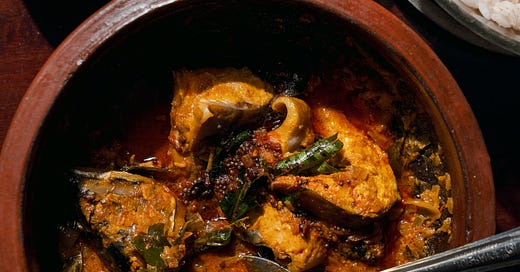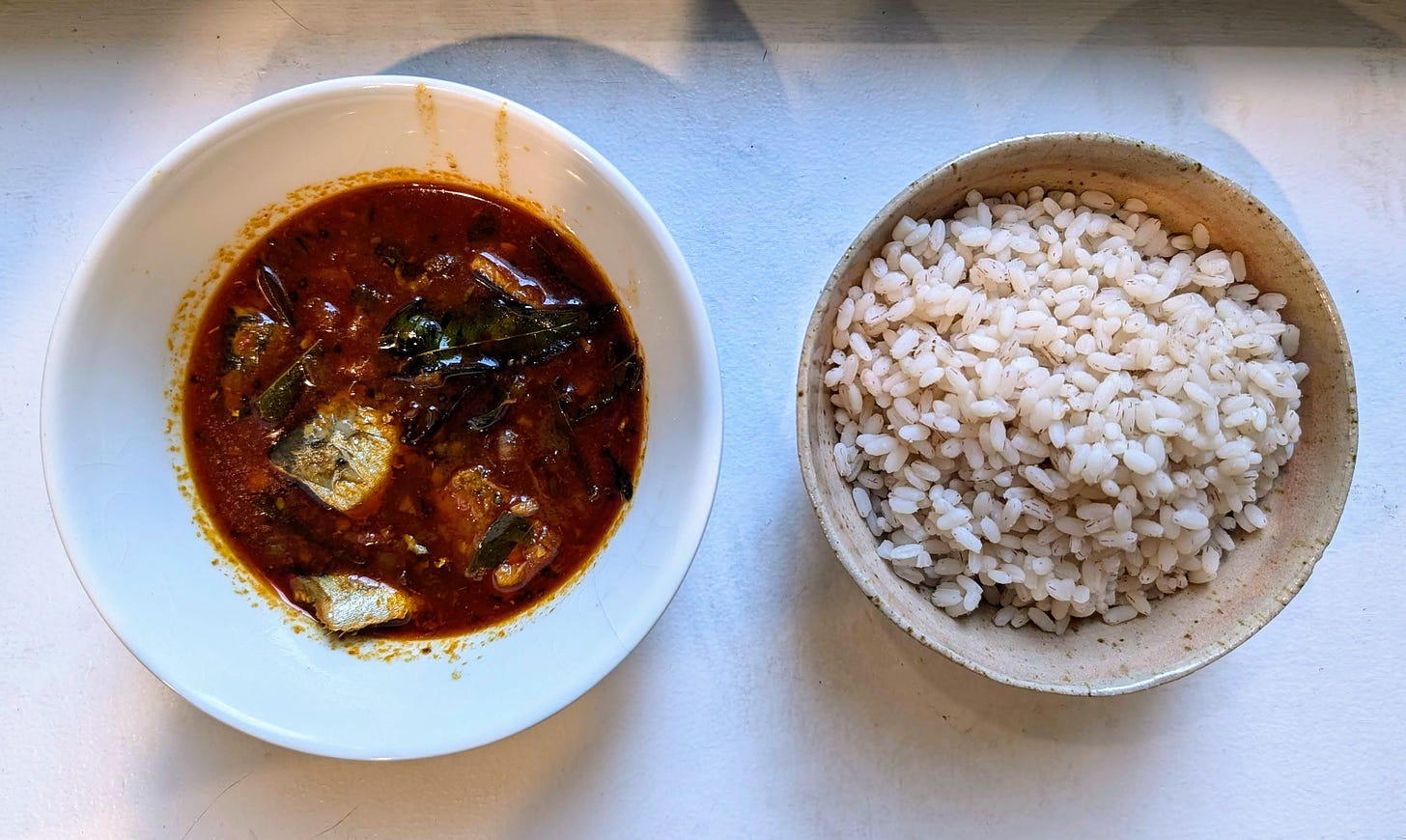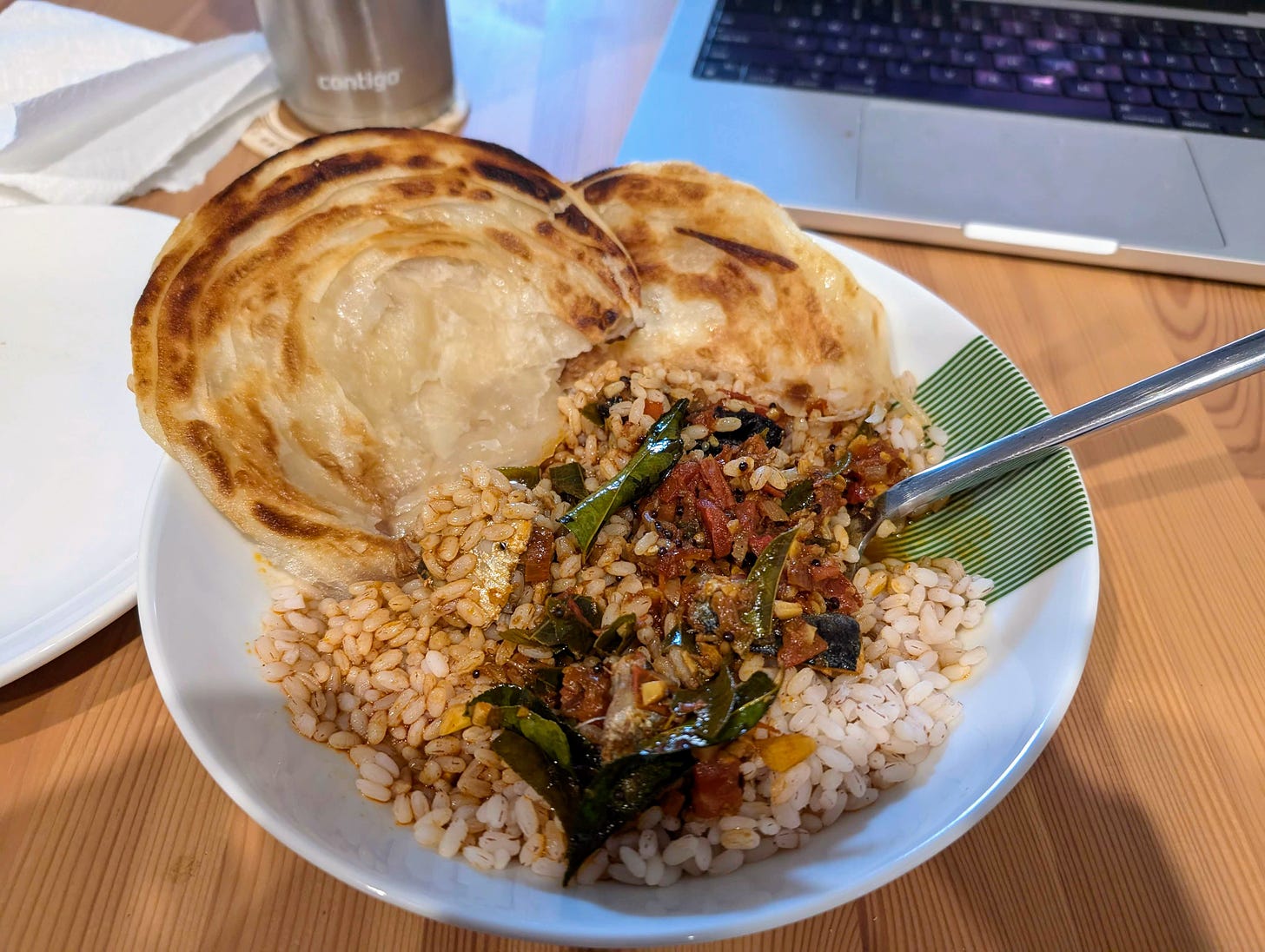Saying Sorry with a Pot of Curry
Cooking as communication in All We Imagine As Light, one of the year’s best movies. Recipe for a yummy Kerala fish curry inside!!
“Cooking is a love language” is a well-worn trope within Asian-centered stories. I haven’t gotten tired of it yet, at least when it comes to movies: our food is awesome and (sometimes) telegenic. Cooking scenes are an efficient narrative shorthand to convey a character’s care and attention towards a loved one. Think of the mouth-watering montage in Ang Lee’s Eat Drink Man Woman, in which the patriarch of a Taiwanese family expertly prepares a massive dinner spread for his three adult daughters. In the span of a few minutes, we’ve understood how much this father dotes on his children, and as a bonus, our appetite has warmed up.
Sometimes, cooking is for sustenance, like the egg and beet green omelette I whipped up for lunch today. But other times, it’s a conversation. Sometimes that discussion is between two cooks: at a recent dinner party, I collaborated with a chef of Ecuadorian and Colombian heritage to create dishes that juxtaposed those cuisines with Vietnamese-American food. In finding the common ground between our specific cuisines, we also found similarities between both of our cultures. Other times, the discussion is from chef to eater. Some of my guests express regret that I don’t get to actually hang out with them while I’m cooking their meal. But I tell them what Juliette Binoche says to her diners in The Taste of Things: “I converse with you in the dining room through what you eat. What more can I say?”
That particular line came to mind during a scene in All We Imagine As Light, a miracle of a movie that won the Grand Prix at this year’s Cannes and has begun its theatrical rollout. (I wrote a brief blurb as part of my New York Film Festival coverage.) While Payal Kapadia, the film’s director, did not make a food movie per se, she did make an all-encompassing movie about life in contemporary Mumbai, a city of many languages and people who take pride in their regional cuisines. Two of the film’s main characters hail from Kerala, a coastal province over 800 miles away from the metropolis. Both Prabha (Kani Kusruti) and Anu (Divya Prabha) are nurses at a small city hospital, and share a cramped flat together1. Owing to their generational divide — Prabha is the head nurse, while Anu is a recent hire — roommate conflicts occur. A big point of contention is over the fact that Anu’s boyfriend is Muslim, and Prabha dismisses him not with outright bigotry, but with a subtler prejudice: she’s just worried for her roommate’s safety and what other people will do. After saying some particularly unkind words, a stricken Anu retreats into her bedroom.
Prabha’s immediate response is to make her roommate’s favorite dish, a vibrantly red fish curry stewed in a clay pot. While the curry simmers, she enters Anu’s room, leading not with “I’m sorry,” or “how are you feeling,” but with three words that every type of Asian will recognize to be a mea culpa: I made food. This apology scene is so compelling because it feels so real; Prabha can’t look Anu in the eyes because she’s so ashamed of what she said. This is genuine contrition, and to make up for her transgression, Prabha provides her roommate with a taste of home. Eventually, they sit down to eat together2, and by the end of the film, on a placid beach far from the alienation of Mumbai, Prabha eventually comes around to support Anu’s relationship. All We Imagine As Light is just such a tender film in this way. At its core, it’s a movie about people subtly changing each other and helping each other, some optimism (a ray of light, perhaps) to be found in a world of late-stage capitalism.
How To Make Kerala Fish Curry
Immediately after I got out of my screening of All We Imagine As Light, I texted my good friend Shruti, who hails from the same part of India as Prabha and Anu. Coincidentally, she was planning to make a video showcasing the exact Nadan Style Meen Curry that we see Prabha prepare for her roommate, which Shruti says is “the Kerala fish curry.”
(If the embedded Instagram reel doesn’t work, click here.)
Shruti sent me her mom’s recipe for the curry earlier this week, and I made time to try it out. You have to go to an Indian grocery store to get some essential ingredients, but it’s otherwise super easy to make, with just two pots required. And it’s absolutely delicious. A hearty fish is stewed in a broth infused with kodampuli (Malabar tamarind), tomatoes, chiles, and a lotta spices. It’s a wonderful combination of a non-puckering sour tang with earthy, spicy heat, especially when served with red matta rice.
The full recipe for Nadan Style Meen Curry can be found on her brand new Substack, Camera Eats First. (Go subscribe!)
And here are some of my own notes and pics from testing out the dish. It was so good that I am making it again tonight, and I almost never repeat recipes within the same week.



Shruti’s family uses mackerel, but she notes that you can switch it up based on preferences and availability. I’m a huge mackerel stan, but they didn’t have any at Eataly, so I got some sardines instead. (I didn’t realize until I got home that they weren’t cleaned, so I learned how easy it is to scale and gut a fish.) Today, I got a fillet of black sea bass, which hopefully won’t break apart too much.
The kodampuli and curry leaves are non-negotiable as they give this curry its distinct flavor. Without them, it would not be a Kerala curry. I got mine at Kalustyan's, the always reliable Manhattan spice shop, and I’m sure Patel Brothers in Jackson Heights will have your back.
How to eat the meen curry with rice:
Even though I put the curry on a mountain of matta rice, I wanted bread. Frozen malabar parathas can be found in any Indian grocery store. They are already cooked so you just have to quickly fry them in a lightly oiled skillet until it’s charred to your liking
Some Recommended Reading
In making All We Imagine As Light, Payal Kapadia seems to have taken a lot of visual inspiration from Wong Kar-Wai’s movies, although her camera is much more restrained than the likes of Chungking Express. Both this film and In the Mood For Love place a lot of importance on the electric rice cooker. And Kapadia and Wong are two filmmakers who tell political stories, even if it’s not immediately recognizable to an international viewer.
Two new interviews with Payal Kapadia illuminate the political elements of All We Imagine As Light, within the film itself as well as the context surrounding its release. Whether or not you’ve seen the movie, check out Siddhant Adlakha’s piece in TIME as well as Bedatri D. Choudhury’s interview for Filmmaker Magazine. And then see this brilliant movie!
The third central character, who is no less important to this film, is Parvaty (Chhaya Kadam), the hospital’s cook, who faces eviction to make way for a luxury high-rise.
I have to admit that this might not be exactly how this conflict gets resolved as I saw the movie over a month ago, and didn’t write down the entire plot in my notes. But I’m pretty sure this is how it went down.















